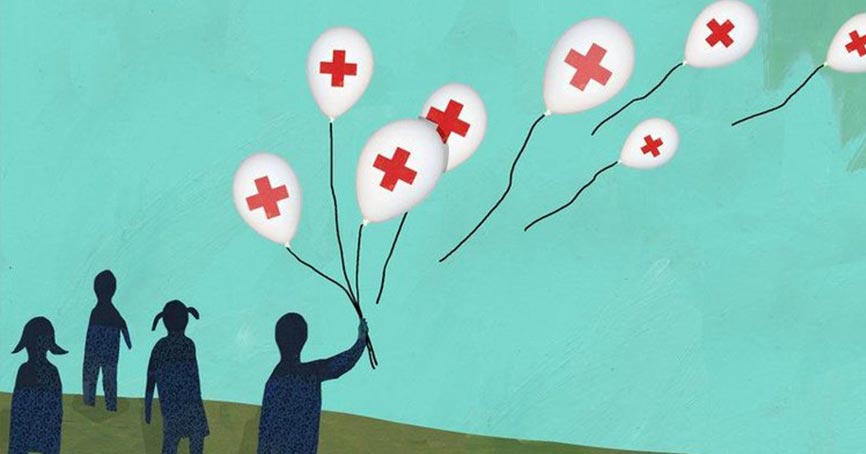Leukaemia is a type of cancer of the blood cells. Among different categories of blood cells, leukaemia deals with the cancers of the white blood cells. Leukaemia is the cancer of the blood cells, seen due to a rise in the number of white blood cells.
White blood cells are a vital part of the immune system protecting the body from invasion of bacteria, fungi and virus, among abnormal cells and other foreign substances. In a person suffering from leukaemia, the white blood cells do not function like normal white blood cells. They divide too quickly, crowding out the normal cells.
WBCs are generally produced in the bone marrow, however, certain WBCs are also produced in the spleen, thymus gland and lymph nodes. After its formation, WBCs circulate through the body in the blood and lymph, concentrating in the lymph nodes and spleen.
Types of Leukemia
Depending on the body type of a person, the onset of leukaemia may be chronic (slow) or acute (sudden). In acute leukaemia, the cancer cells multiply real quick but in chronic leukaemia, the disease progresses slowly, showing mild leukaemia early symptoms.
Leukaemia is of different types depending on the type of cell that has been affected. The four main types of leukaemia are-
Acute Myelogenous Leukemia (AML)
Acute Myelogenous Leukemia (AML) occurs in the blood and bone marrow. The marrow is a sponge-like material inside the bones that produces blood cells. It affects the white blood cells of the body as they form abnormally and grow. Annually, there are about
20830 new cases of AML.
Acute Lymphocytic Leukaemia (ALL)
Acute Lymphocytic Leukemia is more common in children than it adults. It is a cancer of the bone marrow and blood that occurs when abnormal cells begin to grow out of control. ALL is mainly due to an increase in white blood cells known as lymphocytes. As it is an acute and aggressive form of cancer, it moves rapidly.
ALL has a good chance of remission in children than in adults. Annually, there are about
6050 new cases of ALL in the United States alone.
Chronic Myelogenous Leukaemia (CML)
Chronic myelogenous leukaemia is a cancer of the white blood cells. In CML, the immature WBSs or blast cells form and multiply uncontrollably crowding out all other types of necessary blood cells. Annullu, there are about
9000 new cases of CML. However, the survival rate for CML is quite great.
Chronic Lymphocytic Leukaemia (CLL)
Chronic Lymphocytic Leukemia affects the lymphocytes that are a type of white blood cells. CLL affects the B lymphocytes, known as B cells. While the normal B cells circulate in the body to fight infection, cancerous B cells do not do so normally. As the number of cancerous B cells increases, the normal lymphocytes have no place left, ultimately leading to bone marrow failure.
Hairy Cell Leukemia is a rare form of CLL, whose name comes from the appearance of cancerous lymphocytes under a microscope.
Symptoms of Leukemia
Leukaemia has a few signs and symptoms that can help identify cancer. The symptoms of leukaemia include-
Poor Blood Clotting- Platelets are crucial for blood clotting and immature white blood cells overpower the platelets. This would result in easy bleeding but slow healing. The diagnosed patient may develop small red to purple spots on the body, indicating a haemorrhage.
Anaemia- Anemia is a result of the shortage of good red blood cells. This would have signs of difficulty in breathing and pale skin.
Frequent Infections- White blood cells function also includes fighting infection. If they are unable to do their work properly, it may result in frequent infections. The immune system would attack other good body cells.
Other Symptoms-A person suffering from leukaemia may experience fever, chills, nausea, night sweats, weight loss, bone pain, flu-like symptoms and tiredness. Moreover, the person may also suffer from enlargement of the liver or spleen, which would result in weight loss. This happens because the person feels fuller for a longer period of time, resulting in weight loss.
Leukaemia early symptoms
Besides, some of the other symptoms are-
- A headache that indicates that the cells have come into the central nervous system.
- Bleeding from the gums
- Bleeding from the skin
- Lymphadenopathy, enlarged lymph nodes in the neck, arms or groin region
- Joint Pain
- Weakness
- Fatigue
- cranial nerve palsies
- testicular enlargement
However, it is important to bear in mind that these symptoms can be due to other illnesses as well. For a confirmed leukemia diagnosis, tests are required.
Causes of Leukemia
A person suffers from Leukemia when the DNA of the immature blood cells, mainly WBCs, becomes damaged in any way. Due to this, the blood cells grow and divide continuously dividing into multiple cells.
Usually, the healthy blood cells die after a while and are replaced by new cells in the bone marrow. On the other hand, the abnormal cells do not die as per the normal cycle and eventually accumulate occupying more space.
As the cancer cells spread around the body, the healthy cells are unable to grow and function normally. Over time, the bad cells are more than the good cells in the blood.
Bibliography
- https://www.mayoclinic.org/diseases-conditions/leukemia/symptoms-causes/syc-20374373
- https://www.healthline.com/health/leukemia#symptoms
- https://www.webmd.com/cancer/lymphoma/understanding-leukemia-basics#1
- https://www.medicalnewstoday.com/articles/142595.php
- https://www.healthline.com/health/acute-lymphocytic-leukemia-all#symptoms

 Jun 03, 2019
Jun 03, 2019
 May 30, 2018
May 30, 2018 May 10, 2018
May 10, 2018 May 17, 2018
May 17, 2018